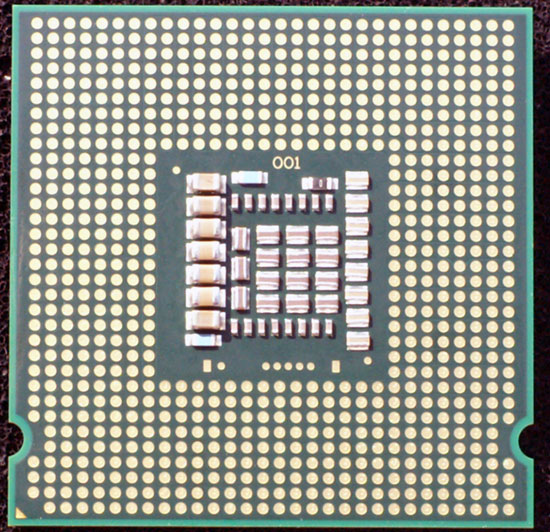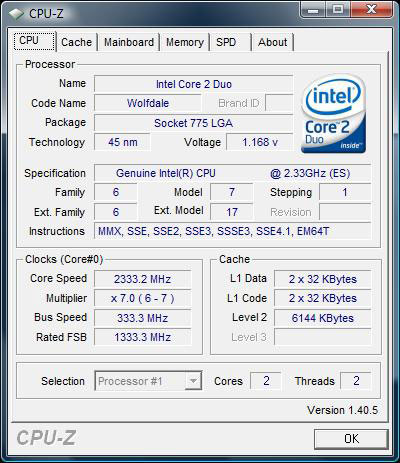The Penryn Preview - Part I: Wolfdale Performance
by Anand Lal Shimpi on August 21, 2007 12:35 PM EST- Posted in
- CPUs
Penryn's Launch Schedule
The launch will work like this: late this year (Q4), Intel will introduce a a new Extreme Edition processor based on Yorkfield (quad-core Penryn). Given that most Extreme Edition chips start out with a $999 price tag, that's where we'd expect the first quad-core Penryn to fall as well.
More affordable Penryn won't arrive until Q1 2008, which is great news for AMD. In the beginning of next year, Intel will introduce both mainstream Yorkfield and Wolfdale (dual-core Penryn) parts. We'd expect Wolfdale based chips to run at between 2.33GHz and 3.00GHz, while Yorkfield will probably top out at 3.33GHz.
In Q2 2008, Intel will push Penryn even further down the line and introduce a Wolfdale based E4xxx successor. This version of Wolfdale will have a 1066MHz FSB and drops support for Intel Virtualization Technology and TXT.
The Chip
Intel is keeping its few remaining cards close at hand, and thus it is only sampling lowly 2.33GHz Wolfdale/Yorkfield chips. It's not an issue of getting the 45nm process to clock high enough (as you'll see from our overclocking tests), so we'd guess that Intel doesn't want to have the performance of its top of the line 3.33GHz Yorkfield leaked until after Phenom hits.

Wolfdale's underside - we have to hide the other side so Intel doesn't murder our mole in its sleep

Conroe's belly for comparison
The 2.33GHz Wolfdale we're looking at today is best compared to the Core 2 Duo E6550 (2.33GHz Conroe), and that's exactly what we're doing.

Our Wolfdale is also not the final stepping that will be shipping next year; we've got A0 silicon and A1 should be ready in the coming weeks. Despite the not-final state of the silicon, we had absolutely no problems with the chip in our test bed. We tossed it in our Gigabyte GA-P35C-DS3R test bed and ran through a subset of our test suite without so much as a BIOS update. We are waiting on the first Penryn-tuned motherboards and BIOSes to arrive, so performance may increase from where we're at today.
The Test
| CPU: | Intel Core 2 Duo E6550 (2.33GHz/1333MHz) Intel Wolfdale 2.33GHz/1333MHz |
| Motherboard: | Gigabyte GA-P35C-DS3R (Intel P35) |
| Chipset: | Intel P35 |
| Chipset Drivers: | Intel 8.1.1.1010 (Intel) |
| Hard Disk: | Seagate 7200.9 300GB SATA |
| Memory: | Corsair XMS2 DDR2-800 4-4-4-12 (1GB x 2) |
| Video Card: | NVIDIA GeForce 8800 GTX |
| Video Drivers: | NVIDIA ForceWare 158.18 |
| Desktop Resolution: | 1600 x 1200 |
| OS: | Windows Vista Ultimate 32-bit |










55 Comments
View All Comments
zsdersw - Tuesday, August 21, 2007 - link
The idiots who predicted a "huge improvement" existed only in your mind, I suspect.. or were never a group of any nominal size to begin with.sprockkets - Wednesday, August 22, 2007 - link
Not really. Search even this site and find stories like "30% improvement over Conroe." They painted Penryn as if it was such a major advance in technology that it would obliterate anything or anyone period had on the planet.sprockkets - Wednesday, August 22, 2007 - link
Yeah, here:http://www.dailytech.com/Intel+Unveils+Penryn+Perf...">Daily Tech Penryn "Benchmarks"
Funny How Intel benchmarked the processors and got "amazing" benefits over the previous generation. Of course they didn't do a clock for clock comparision.
coldpower27 - Thursday, August 23, 2007 - link
Most people were claiming was 5-10% improvement per clock over Conroe, and that is what the data from Anandtech and HKEPC shows, if your talking overall improvements that is trickier as it would depend on what the clockspeed as well, so up to 30%, is not impossible given the right circumstances and depending on what Yorkfield XE tops out at.Performance is not derived from just a clock per clock comparison, you also have to take into account overall clockspeed increases, cache, FSB. Don't expect any corporation to put their processors in any sort of unflattering light, it is in their best interest to make themselves look good, not bad.
zsdersw - Thursday, August 23, 2007 - link
Nowhere in the comments of that story did anyone make any wild performance claims.sprockkets - Friday, August 24, 2007 - link
No, I don't see any inflation here at all.
And if AMD can make a processor run at 3ghz on 90nm, uh, yeah, kinda expect a processor 2 generations down the process line to be able to reach 3.3ghz without issues.
zsdersw - Wednesday, August 22, 2007 - link
Again, not a group of people big enough to be significant.dualathlon - Tuesday, August 21, 2007 - link
Would you please include some wu benchmarks from FAH ?Thanks.
Rebel44 - Tuesday, August 21, 2007 - link
I would also like to see some F@H benchmarks.conquerist - Tuesday, August 21, 2007 - link
1) What HSF was used for the OC? The stock HSF or the Thermalright Ultra 120 Extreme?2) As mentioned before, how does it OC at a higher Vcore?
3) Could you use x264 for the multimedia tests? I suggest this because x264 is open source, and so you can use Intel Compiler 10 or GCC 4.3 with the msse4.1 switch to compile it in SSE4.1! It would be interesting to see how Conrow vs. Penryn SSE3 vs. Penryn SSE4 compare. You can grab a daily tarball of the source at ftp://ftp.videolan.org/pub/videolan/x264/snapshots...">ftp://ftp.videolan.org/pub/videolan/x264/snapshots....